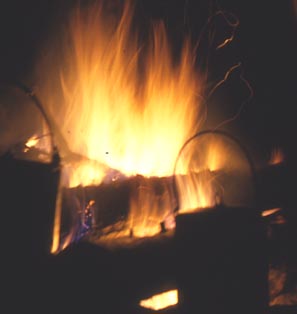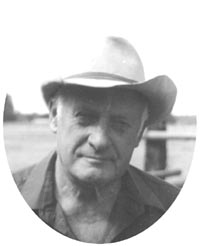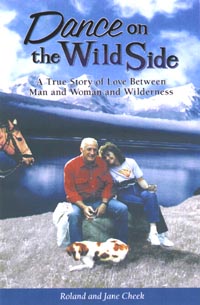a weblog sharing info on outdoor skills and campfire musing by a guy who spends a bunch of time in pursuit of both
CULTURE
WHERE -
TALES ARE TOLD OF
Welcome to Roland Cheek's Weblog
Roland is a gifted writer with a knack for clarifying reality. Looking forward to more of his wisdom
- Carl Hanner e-mail
Aldo Leopold wrote in A Sand County Almanac: "When I first saw the West, there were grizzlies in every major mountain mass." Then he added, ". . . Of the 6000 grizzlies officially reported as remaining in areas owned by the United States, 5000 are in Alaska. Only five states have any at all. There seems to be a tacit assumption that if grizzlies survive in Canada and Alaska, that is good enough. It is not good enough for me. The Alaskan bears are a distinct species. Relegating grizzlies to Alaska is about like relegating happiness to heaven; one may never get there."
To access Roland's weblog and column archives
Tip o' the Day
"Never shoot from 10 a.m. to 3 p.m."
"Seek wildlife subjects that are conditioned to human presence."
"Make sure there's a glint in the eyeball of your subject."
"Photograph people with wildlfie when possible."
All the above advice came from a few of the best wildlife photographers in America. It was during a panel on "Wildlife Photography" at a convention of Outdoor Writers Association of America, back in the 1980s (before digital cameras). I shrugged, smiled in chagrin, and sighed.
There was a time when I would've scribbled furiously at each pearl of wisdom falling from those photographers' lips (I once dreamed of becoming a successful wildlife photographer). That dream -- like a few others -- was discarded when facing reality: that my dogged pursuit of another way of life clashed with making a success of wildlife photography.
At the time of that OWAA annual convention I'd worked as an outfitter and guide in the Bob Marshall Wilderness for nearly two decades, and had been writing newspaper columns about those adventures for six years. Too, I'd photographed and written a coffee table book about that wilderness. But my occupation did not permit exercising the kind of patience necessary for becoming a photographer of wild creatures. To capture wildlife on film, a photographer's first commitment is to his photograph. In my primary occupation, my first commitment had to be the guests I was leading to adventure.
I sighed again. All those top photographers said they seldom use a normal camera lens (55mm). Instead, they use telephoto lenses to 400mm. But the higher-powered lenses are used only with a tripod or stock-mounted support device. Each sometimes shot from blinds -- usually ones they build themselves, going to considerable effort to construct a blend-with-the-surroundings way to stay hidden near a waterhole, meadow, or major game crossing.
Obviously the 10-to-3 edict is to avoid the flat light of midday.
Seeking wildlife subjects conditioned to human presence means shooting for the most part in National Parks or Wildlife Refuges.
The glint-in-the-eye injects life in the animal, but it doesn't mean not shooting a pack of wolves battling a grizzly bear just because you can't get them to stop long enough to capture the glint.
Three years later Jane and I sold our guide service and most of our horses and tack. I remembered the old dream, purchased two top-of-the-line Nikon camera bodies and a powerful variable lens to 200mm, then set out to add support photos to magazine pieces cranked out regularly to America's top outdoor magazines. It wasn't long, however, that I noticed something: the magazines were buying my stories, but they always used someone else's photographs.
My conclusion? Photographers should photograph, writers should write. And never the twain should meet.
GUN ACCIDENTS -- THE HARD LESSON!
The lessons are hard, but necessary. Fortunately, the truth is that most accidental gun discharges are caused by novice gun-handlers and result in no bodily injury to humans. Usually there's little property damage and all too often individuals shrug off the unexpected discharge as a mistake "with no harm done." But professionals--law enforcement personnel, professional guides, soldiers--tend to take a different, more jaundiced view.
One accidental discharge is all I can recollect during my guiding years. But one is light years more than none, and zero tolerance is the only goal for which a hunter must strive.
I'm not sure what happened, but it occurred in a tiny covered breezeway between our camp's sleeping tent and cooktent. I was in the latter, cleaning up after breakfast; hunters and guides were preparing to depart for the day's hunt. Most were collecting gear in the sleeping tent. One nimrod was apparently checking his rifle--he said he wasn't loading it, but that's questionable.
The gun roared! It did so in a confined four-by-six space; only tent fabric separated the .300 magnum's muzzle from all of the camp's other human occupants. Horses stamped nervously at hitchracks, or ran snorting in the corral just beyond the tents.
I burst through the tent flap, terror-stricken that someone had been shot. Just as I burst from the cooktent, one of our other hunters flung the sleeping tent flap aside. "Who did that!" he screamed.
The man who'd caused the accidental discharge stared stupidly at his weapon. He seemed to shrink, near tears, thrusting the gun first at me, then at his companion. "I . . . I don't know what happened. It just . . . just went off!"
"You idiot!" the other hunter screamed. "You bloody, blithering idiot!" He looked at me. "Are ou all right?" Then he remembered his best friend. "Jim! Jim! Are you all right."
Jim pushed into the alcove. "What happened?" he asked.
I looked for the bullet's path. There was a hole in the soil, at the man's feet, perhaps a foot ahead of his toes. Clods of dirt had been blown up on the woodpile that occupied half the alcove. It was obvious the gun handler had at least held the rifle's muzzle in a precautionary direction.
The man's face still flamed scarlet. "It wasn't me," he said. "The gun . . . it was the gun. Somehow it fired."
I gazed beyond. The faces of the other hunters and their guides shined in the burgeoning morning light. "Is everyone all right?" I asked. Murmurs of assent were returned. All were accounted for.
What are you going to do?" the angry hunter demanded, meaning by his question that I should visit some terrible wrath on the errant hunter. For his part, the guy who'd blasted a hole in the dirt stared up in anguish, apparently expecting punishment for an infraction that I was ill-equipped, either by inclination or experience, to handle.
I walked out to greet the dawn. "Reckon the elk will think we're so desperate for meat that we're shooting ourselves amongst the tents?" I mused.
"Come on Joe," one of the guides murmured, "shake it off and let's get a move on." Joe stared long and hard at me, then pushed on out of the alcove, moved some distance away, and carefully jacked the remaining shells from his rifle's magazine. When he finished, he again stared at me, then strode to his waiting horse and slipped the magnum into its saddle scabbard.
After guides and hunters had ridden from camp, I returned to my dishpan with plenty of time to think:
It was a lesson that could've gone either way.
Roland Cheek wrote a syndicated outdoors column (WildTrails and Tall Tales) for 21 years. The column was carried in 17 daily and weekly newspapers in two states. In addition, he scripted and broadcast a daily radio show (Trails to Outdoor Adventure) that aired on 75 stations from the Atlantic seaboard to the Pacific Ocean. He's also written upwards of 200 magazine articles and 12 fiction and nonfiction books. For more on Roland, visit:
www.rolandcheek.com
Recent Weblogs
Tuesday, November 11, 2008
for more info about these and other Roland Cheek books
There's a bunch of specific info about Roland's books, columns, and archives. By clicking on the button to the left, one can see Roland's synopsis of each book, read reviews, and even access the first chapter of each of his titles. With Roland's books, there's no reason to buy a "pig in a poke."
for detailed info about each of Roland's books
Read Reviews
Read their first chapters
For interested educators, this weblog is especially applicable for use in history, economic, and government classes, as well as for journalism students.
Roland, of course, visits schools. For more information on his program alternatives, go to:
NEXT WEEK:
EVERY HUNTER'S DREAM
www.campfireculture.com
Learning To Talk Bear is Roland's best-selling book, now in its 5th printing. About the book, he writes: "Grizzlies . . . are the Marine Band of the animal world. They swagger with the calm indifference of an animal who knows he has nothing left to prove. . . .
"Not all grizzly bears are Jeffrey Dahmers or Jack the Rippers in fur coats. Perhaps that the "why" for this book."
Roland writes: "Elk took me the wildlife dance over 50 years ago. I became an elk hunter. Then I became infatuated with all God's creatures, and eventually a believer that God's handiwork is composed of such intracacies that a quest to understand has taken the rest of my life. The Phantom Ghost of Harriet Lou is about that quest."
Roland says about Dance On the Wild Side: "This book is about two people in love, sharing a life of dreams amid exciting adventure -- and growing in the process. In reality, it's about any couple who live and love and share and sruggle to achieve the life they wish.
An entire book about a single grizzly bear, a bear that made the pages of The New York Times. Chocolate Legs is a first class murder mystery that may leave you wondering if justice was done
America's first book about what one U.S. Forest Service Chief called, "The Crown Jewel of the Wilderness System." 9 X 12 coffee table size / 97 full-color photos.
One hundred of the best of Roland's 2,700 past newspaper columns and radio scripts
First book in Roland's popular Valediction For Revenge western series
source links for additional info
to send this weblog to a friend
to tell Roland what you think of his Campfire Culture weblog
to visit Roland's newspaper columns and weblog archives









